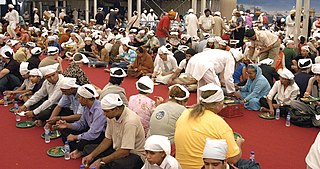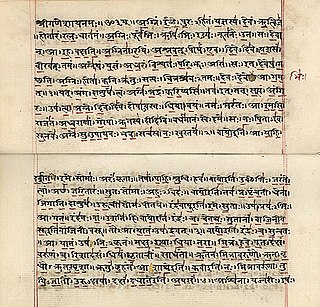 W
WAmrit Velā begins at the start of a new day, therefore, begins at 3:00 am and ends at 6:00 am, [1] which is used for daily meditation and recitation of Gurbani hymns. Guru Nanak in the Japji Sahib says, "During the hours of Amrit velā, meditate on the grandeur of the one true Name."[1] The importance of Amrit Vela is found throughout the Guru Granth Sahib. The Guru Granth Sahib states that "those who consider themselves a Sikh must wake up daily at Amrit Vela and be in tune with the Naam "[3]
 W
WAnand Karaj is the Sikh marriage ceremony, meaning "Act towards happiness" or "Act towards happy life", that was introduced by Guru Amar Das ji. The four laavaan were composed by his successor, Guru Ram Das ji. It was originally legalised in India through the passage of the Anand Marriage Act of 1909, but is now governed by the Sikh Reht Maryada that was issued by the Shiromani Gurdwara Prabandhak Committee (SGPC).
 W
WThe Anand Sahib is a collection of hymns in Sikhism, written in the Ramkali Raag by Guru Amar Das Ji, the third Guru of the Sikhs. It appears on the pages 917 to 922 in Guru Granth Sahib Ji. The word Anand means complete happiness.
 W
WThe Ardās is a set prayer in Sikhism. It is a part of worship service in a Gurdwara, daily rituals such as the opening the Guru Granth Sahib for prakash or closing it for sukhasan in larger Gurdwaras, closing of congregational worship in smaller Gurdwaras, rites-of-passages such as with the naming of child or the cremation of a loved one, daily prayer by devout Sikhs and any significant Sikh ceremonies.
 W
WAsa Di Var is a collection of 24 stanzas (pauris) in the Guru Granth Sahib, from ang 462 to ang 475.
 W
WBenti Chaupai is a hymn by Guru Gobind Singh. Chaupai is the 404th Charitar of the Charitropakhyan of the Dasam Granth and is a part of a Sikh's Nitnem. Chaupai Sahib begins after the 404 Chittar where two massive battles, including the later between Maha Kal and the devils, is narrated and the struggle of a goddess that was born as a result of the first battle and her quest for the acceptance of the Supreme Being, by her abandoning all other worldly desires, is illustrated.
 W
WDarbar Sahib literally means the Royal Court, and often refers to the main room within a Gurdwara. This room is where Sache Patshah Sri Guru Granth Sahib Ji sits on a raised throne, or takht in a prominent central position.
 W
WThe initiated Sikh is asked by the Panj Piare during the Amrit Sanchar ceremony to recite the following five banis as a commitment to the Sikh Gurus and Waheguru.
 W
WA Granthi is a person, female or male, of the Sikh religion who is a ceremonial reader of the Sri Guru Granth Sahib, which is the Holy Book in Sikhism, often read to worshipers at Sikh temples called a Gurudwara. The name Granthi comes from the Sanskrit granthika, which means a relater or narrator. Any Sikh individual appointed the title of being a Granthi is considered a principal religious official of Sikhism. Although they are considered religious officials in Sikhism, they are not considered to be the equivalent of a priest, as the belief is that there are no such religious intermediaries.
 W
WGurbani is a Sikh term, very commonly used by Sikhs to refer to various compositions by the Sikh Gurus and other writers of Guru Granth Sahib. In general, hymns in the central text of the Sikhs, the Guru Granth Sahib, are called Gurbani. Among Amritdhari Sikhs, a few texts from Dasam Granth which are read as Nitnem, like Tav-Prasad Savaiye and Chaupai, are also considered Gurbani. In Adi Granth, Gurbani is a sound which comes directly from the Supreme and the text is a written form of the same in worldly language and scripts. It is also called Guru´s Bani. Gurbani are explanations of qualities of the Primal Lord and Soul which a Sikh should comprehend and with which he can attain the supreme state.
 W
WThe Guru Granth Sahib is the central holy religious scripture of Sikhism, regarded by Sikhs as the final, sovereign and eternal Guru following the lineage of the ten human gurus of the religion. The Adi Granth, its first rendition, was compiled by the fifth guru, Guru Arjan (1564–1606). Its compilation was completed on 29 August 1604 and first installed inside Golden Temple in Amritsar on 1 September 1604. Baba Buddha was appointed the first Granthi of the Golden Temple. Shortly afterwards Guru Hargobind added Ramkali Ki Vaar. Later, Guru Gobind Singh, the tenth Sikh guru, added hymns of Guru Tegh Bahadur to the Adi Granth and affirmed the text as his successor. This second rendition became known as the Guru Granth Sahib and is also sometimes referred to as the Adi Granth.
 W
W"Guru Maneyo Granth" refers to the historic statement of the 10th Sikh Guru, Guru Gobind Singh (1666–1708) shortly before his demise on affirming the sacred scripture Adi Granth as his successor, thereby terminating the line of human Gurus. Installed as the Guru Granth Sahib, it is now the central holy scripture of Sikhism, and the eternal living Guru of all Sikhs. It is central to Sikh worship as it is said to imbibe the one light of the creator manifested in the Ten Sikh Gurus—one spirit in ten forms.
 W
WA gyani or giani is an honorific Sikh title used by someone learned in the Sikh religion and who often leads the congregation in prayers, such as Ardas, or in singing (kirtan). The word ghian means "knowledge" in Punjabi, being a derivative of the Sanskrit word jnana. So a "gyani" is one who has spiritual and religious knowledge and can help the congregation—the Sadh Sangat—in understanding the Sacred Texts and the history of the religion.
 W
WIk Onkar, also spelled Ek Onkar ; literally, "There is only one God or One creator or one Om-maker") is a phrase in Sikhism that denotes the one supreme reality. It is a central tenet of Sikh religious philosophy.
 W
WJaap Sahib is the morning prayer of the Sikhs. The beaded prayers were composed by the Tenth Sikh Guru, Guru Gobind Singh and is found at the start of the Sikh scripture Dasam Granth. This Bani is an important Sikh prayer, and is recited by the Panj Pyare while preparing Amrit on the occasion of Amrit Sanchar (initiation), a ceremony held to admit initiates into the Khalsa and it is a part of a Sikh's Nitnem. The Jaap Sahib is reminiscent of Japji Sahib composed by Guru Nanak, and both praise God.
 W
WThe Jathedar of the Akal Takht, is the appointed head of the Akal Takht and the Sikhs of the world. Sikh clergy consists of five Jathedars, one each from five Takhts.
 W
WKacchera or Kachera are an undergarment for the lower body that is specially tailored for shalwar with a tie-knot naala or naada (drawstring) worn by fully initiated Sikhs. They are similar to European boxer shorts in appearance. It is one of the five Sikh articles of faith called the Five Ks, and was given from Guru Gobind Singh at the Baisakhi Amrit Sanskar in 1699. Kacchera have been worn by initiated Sikhs (Khalsa) since a mandatory religious commandment given by Guru Gobind Singh, the tenth Guru of Sikhism, in 1699. Both male and female Sikhs wear similar undergarments. This is one of five articles of faith—collectively called "Kakkars"—that form the external, visible symbols clearly and outwardly displaying one's commitment and dedication to the order (Hukam) of the tenth master.
 W
WA kangha (Hindi) is a small wooden comb that Sikhs usually use twice a day. It is supposed to be kept with the hair at all times. Combs help to clean the hair, and are a symbol of cleanliness. Combing their hair reminds Sikhs that their lives should be tidy and organised. The kangha makes the uncut hair neat and keeps away tangles. Kanghas were traditionally made of wood, but many modern Sikhs employ ones made of plastic.
 W
WA kara is a steel or cast iron bangle worn by Sikhs who have been initiated into the Khalsa. It is one of the five kakars or five Ks — external articles of faith — that identify a Sikh as dedicated to their religious order. The kara was instituted by the tenth Sikh guru Gobind Singh at the Baisakhi Amrit Sanchar in 1699. Guru Gobind Singh Ji explained:He does not recognize anyone else except me, not even the bestowal of charities, performance of merciful acts, austerities and restraint on pilgrim-stations; the perfect light of the Lord illuminates his heart, then consider him as the immaculate Khalsa.
 W
WIn Sikhism, Karah is a type of whole wheat flour halva made with equal portions of whole-wheat flour, clarified butter, and sugar. It is offered to all visitors to the Darbar Sahib in a Gurdwara. It is regarded as a treat for attendees of gurmat seminars. As a sign of humanity and respect, visitors accept the Karah sitting, with hands raised and cupped. The offering and receiving of this food is a vital part of hospitality protocols. It has the same amount of whole-wheat flour, clarified butter and sugar, to emphasize the equality of men and women. The Sewadar serves it out of the same bowl to everyone in equal portions. The Karah prasad is a sacred food; if it is not accepted, it may be interpreted by some Sikhs as an insult. Karah is also taken at the initiation ceremony of Amrit Sanchar at the very end where it is shared out equally among all. It is a symbol showing that everyone is equal.
 W
WIn Sikhism, kesh is the practice of allowing one's hair to grow naturally out of respect for the perfection of God's creation. The practice is one of The Five Kakaars, the outward symbols ordered by Guru Gobind Singh in 1699 as a means to profess the Sikh faith. The hair is combed twice daily with a kanga, another of the five Ks, and tied into a simple knot known as a joora or rishi knot. This knot of hair is usually held in place with the kanga and covered by a turban.
 W
WThe khanda is the symbol of the Sikh faith, that attained its current form around the 1930s during the Ghadar Movement.
 W
WThe laava phere are the four hymns of the Anand Karaj which form the main part of this ceremony. The four hymns are from the Guru Granth Sahib, the Sikh holy scriptures and appear on Ang 773 to 774 of the total of 1430. The Laavaan Shabad was written by the Fourth Guru, Guru Ram Daas Ji.
 W
WIn Sikhism, a langar is the community kitchen of a gurdwara which serves free meals to anyone and everyone regardless of their background or beliefs such as caste, religion, gender, economic status, or ethnicity. People sit on the floor and eat together, and the kitchen is maintained and serviced by Sikh community volunteers, while the meals served are always vegetarian to make them available to a wider range of people.
 W
WThe Nishan Sahib is a Sikh triangular flag made of cotton or silk cloth, with a tassel at its end. The word, Nishan Sahib means exalted ensign, and the flag is hoisted on a tall flagpole, outside most Gurdwaras. The flagpole itself, covered with fabric, ends with a Arrow on top. The emblem on the flag is known as Khanda, which depicts a double-edged sword called a khanda (☬) in the centre, a chakkar which is circular, and flanked by two single-edged swords, or kirpans. Almost all Sikh warriors used to wear it in the eighteenth century, and Nihangs of today still do. The Khanda Sahib is not to be confused with the Nihang's Aad Chand which was the first symbol of the Khalsa. The Khanda was not introduced by Guru Hargobind Sahib Ji but it was a plain yellow banner.
 W
WRehras Sahib, commonly known as So dar Rehras, is the daily evening prayer of the Sikhs and is part of Nitnem. It includes hymns from Guru Granth Sahib Ji and Dasam Granth Ji.
 W
WSahajdhari Sikhs is a person who has chosen the path of Sikhism, but has not yet become an Amritdhari. A sahajdhari believes in all the tenets of Sikhism and the teachings of the Sikh Gurus, but may or may not adorn the five symbols of the Sikh faith. This is not to be confused with the term Mona Sikhs or Mona Sardars, that is Sikhs who are of Keshdhari ancestry, but choose to cut their hair, under certain circumstances, especially by deference to Western culture and fashions.
 W
WThe Sarbloh Granth, also called Manglacharan Puran or Sri Manglacharan Ji, is a voluminous scripture, composed of more than 6,500 poetic stanzas. It is considered as an amalgamation of writings of Guru Gobind Singh and other poets.
 W
WSatya is a Sanskrit word loosely translated as truth, essence. It also refers to a virtue in Indian religions, referring to being truthful in one's thought, speech and action. In Yoga, satya is one of five yamas, the virtuous restraint from falsehood and distortion of reality in one's expressions and actions.
 W
WSeva, in Hinduism and Sikhism, is a selfless service that is performed without any expectation of result or award for performing it. In Hinduism, it is also known as karma yoga, as described in the holy scripture the Bhagavata Gita. Such services can be performed to benefit other human beings or society. Seva means "service", referring to the selfless efforts for. A more recent interpretation of the word is "dedication to others".
 W
WThe principal Sikh scripture is the Adi Granth, more commonly called the Guru Granth Sahib. The second most important scripture of the Sikhs is the Dasam Granth. Both of these consist of text which was written or authorised by the Sikh Gurus.